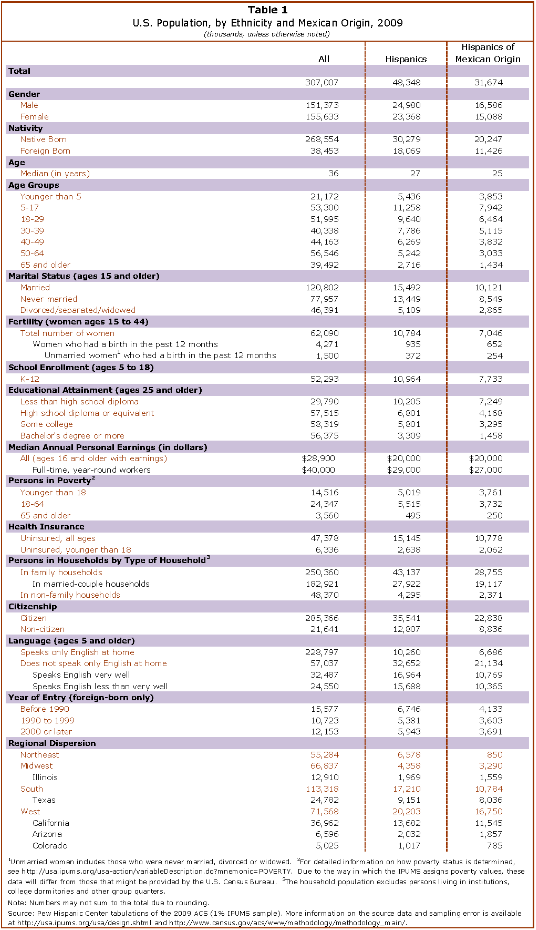An estimated 31.7 million Hispanics of Mexican origin resided in the United States in 2009, according to the Census Bureau’s American Community Survey. Mexicans in this statistical profile are people who self-identified as Hispanics of Mexican origin; this means either they themselves are Mexican immigrants or they trace their family ancestry to Mexico. Mexicans are the largest population of Hispanic origin living in the United States, accounting for nearly two-thirds (65.5%) of the U.S. Hispanic population in 2009.1
This statistical profile compares the demographic, income and economic characteristics of the Mexican population with the characteristics of all Hispanics and the U.S. population overall. It is based on tabulations from the 2009 American Community Survey by the Pew Hispanic Center, a project of the Pew Research Center.2 Key facts include:
- Immigration status. Thirty-six percent of Mexican in the United States are foreign born, compared with 37% of Hispanics and 13% of the U.S. population overall. Most immigrants from Mexico (64%) arrived in the U.S. in 1990 or later. More than two-in-ten Mexican immigrants (23%) are U.S. citizens.
- Language. More than six-in-ten of Mexicans (63%) speak English proficiently.3 Some 37% of Mexicans ages 5 and older report speaking English less than very well, equal to the share among all Hispanics.
- Age. Mexicans are younger than the U.S. population and Hispanics overall. The median age of Mexicans is 25; the median ages of the U.S. population and all Hispanics are 36 and 27, respectively.
- Marital status. Less than half of Mexicans (47%) and Hispanics overall (45%) are married.
- Fertility. Thirty-nine percent of Mexican women ages 15 to 44 who gave birth in the 12 months prior to the survey were unmarried. That was similar to the rate for all Hispanic women—40%—but greater than the rate for U.S. women—35%.
- Regional dispersion. One-third of Mexicans (36%) live in California, and one-in-four (25%) live in Texas.
- Educational attainment. Mexicans have lower levels of education than the Hispanic population overall. Nine percent of Mexicans ages 25 and older—compared with 13% of all U.S. Hispanics—have obtained at least a bachelor’s degree.
- Income. The median annual personal earnings for Mexicans ages 16 and older were $20,000 in 2009; the median earnings for the U.S. population were $28,900.
- Poverty status. The share of Mexicans who live in poverty, 24%, is higher than the rate for the general U.S. population (14%) and similar to the share for all Hispanics (23%).
- Health Insurance. One-third of Mexicans (34%) do not have health insurance compared with 31% of all Hispanics and 15% of the general U.S. population. Additionally, 17% of Mexicans younger than 18 are uninsured.
- Homeownership. The rate of Mexican homeownership (50%) is similar to the rate for all Hispanics (48%) but lower than the 66% rate for the U.S. population as a whole.
About the Data
This statistical profile of Hispanics of Mexican origin is based on the Census Bureau’s 2009 American Community Survey (ACS). The ACS is the largest household survey in the United States, with a sample of about 3 million addresses. The data used for this statistical profile come from 2009 ACS Integrated Public Use Microdata Series (IPUMS), representing a 1% sample of the U.S. population.
Like any survey, estimates from the ACS are subject to sampling error and (potentially) measurement error. Information on the ACS sampling strategy and associated error is available at http://www.census.gov/acs/www/methodology/methodology_main/. An example of measurement error is that citizenship rates for the foreign born are estimated to be overstated in the Decennial Census and other official surveys, such as the ACS (see Jeffrey Passel. “Growing Share of Immigrants Choosing Naturalization,” Pew Hispanic Center, Washington, D.C. (March 28, 2009)). Finally, estimates from the ACS may differ from the Decennial Census or other Census Bureau surveys due to differences in methodology and data collection procedures (see, for example, http://www.census.gov/acs/www/Downloads/methodology/ASA_nelson.pdf, http://www.census.gov/hhes/www/laborfor/laborfactsheet092209.html and http://www.census.gov/hhes/www/poverty/about/datasources/factsheet.html).




